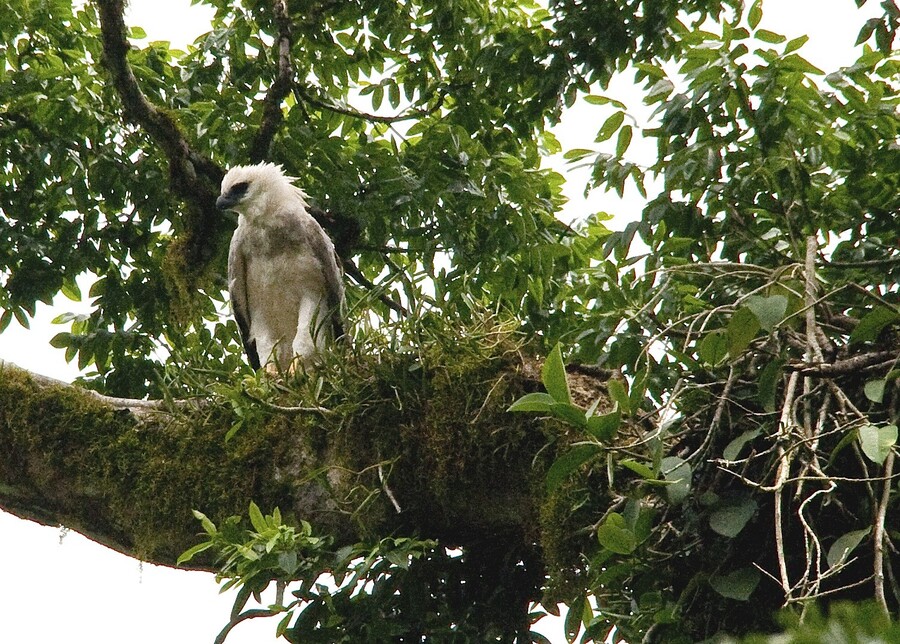First Harpy Eagle's nest in Honduras
Anyone who has ever spotted a Harpy Eagle can consider themselves extremely lucky. The second largest bird in the world hides itself away in the dense jungles of Middle and South America and rears one offspring every 3 to 4 years in a nest that is usually hidden away at a height of 25 to 30 metres above the ground. Observing them, until recently was almost impossible. This is what makes the news from Honduras even more amazing: that a Harpy Eagle's nest with one offspring has been found in the Patuca National Park. This nest is the first one ever to be found in the Middle American State, and what's more, it was discovered by chance. While tracking jaguars for a study, the German nature photographer and filmer Herbert Dohlen and Dr. Louis Perrinjacket, a US tropical doctor, came across the sensation almost by accident. The Harpy Eagle's nest is one of the only three that have ever been documented in the whole of Middle America North of Panama. The other two sightings were made in Belize and Guatemala.Great importance to protect the rain forest Patuca
This find, as unusual as it is, according to experts is very revealing for quite another reason: it illustrates the great importance of the current measures taken to protect the rain forest, and in turn how they assist the protection of species. Which is exactly what is happening in the Patuca National Park. The German conservation organisation Naturefund has been involved with the national park for five years. During this time, together with the national park management of the Asociación Patuca, more than 100 tree nurseries have been built, thousands of trees have been planted every year, and an immeasurable amount of trees have been saved from deforestation.Cooperation with local indigenous population
As Katja Wiese from Naturefund has explained: „This was only possible because we worked together very intensively with the local indigenous population and convinced them of the inestimable value of their rain forest.“ Therefore, as well as the tree nurseries, Naturefund has established the so named „forest garden method“ in the national park. This method allows areas of destroyed forest to be reforested in an affordable way, while at the same time allowing the land to be used for agricultural means. Satellite images from the summer of 2011 show that in the area where Naturefund are active the rain forest is growing back. Even the conservationists didn't expect that all the effort they have put in over the years would be rewarded by such an unusual find. For them, the Harpy Eagle is a symbol that they are walking on the right path, and it is imperative that they continue to do so. As Nelly Paz, director of the Asociación Patuca has said: „We know that the Harpy Eagle needs a large territory of at least 150 square kilometres of dense, continuous forest with no human interruption. It is our long term aim, together with the people who live there, to ensure that this is made possible.“Patuca National Park - young and big
The Patuca National Park was only founded on the 1st of January 1999 and therefore is relatively young. However, it covers an area of 375.584 hectares and is the largest national park in Honduras. It also took a long time for the local people to appreciate the enormous ecological value of their forest. But since the sighting of the Harpy Eagle's offspring, which naturally caught the interest of experts from all over the world, the local people have developed a certain pride in „their national park“. At the same time, a committee of nature conservation organisations and government representatives has been founded to protect the Harpy Eagle. Their future goal is to pull together with all their strength to prevent the destruction of the rain forest and to protect the precious habitats of the Harpy Eagle and many other species. If you would like to make a donation to help protect the Harpy Eagle and the rain forest, please send all donations to the following account: Naturefund e. V., account number: 101261352, bank code number: 51050015, Nassauische Sparkasse, keyword: Patuca. For more information about the rain forest project, you can visit our site at: www.naturefund.de/en/treeTo the press fotos (in German)Press contact Naturefund Naturefund e. V., press relationsSonnenberger Str. 20a, 65193 Wiesbaden
Tel.: +49 611 504 581 011, pressekontakt@naturefund.de
Press contact Asociación Patuca
Nelly Paz, Tel: +504 236 9910, nellypaz@asociacionpatuca.org, Skype: Nelly Paz, Honduras Asociación PatucaColonia Villas del Río,
Bloque D, Casa 1510
Teguicigalpa,
Municipio del Distrito Central,
Honduras, C. A.
www.asociacionpatuca.org P. S. Would you like to receive press releases of Naturefund? You can register here: Register for press releases

